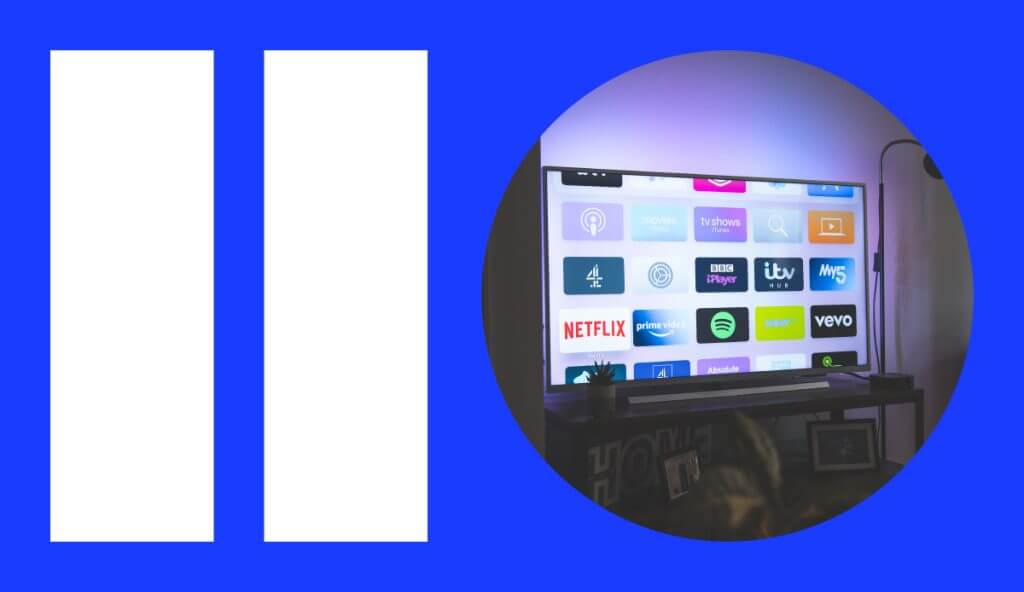Streaming Advertising: The Ultimate Guide to TV Marketing in the Modern Era

Learn how streaming advertising works and how you can use it to reach your target audience
As a marketer, you’re forever asking the question, “What is my audience doing?”
The answer is: They’re probably streaming.
In the U.S., 92% of households are now reachable via a connected TV (CTV). That means more people than ever are watching content online either with a Smart TV or through a connected device, such as a Roku or Amazon Fire TV Stick. Streaming advertising is changing how performance marketers can target, reach, and engage their audience. Read on to learn more about how it works and how to use tools like programmatic TV to make the most out of your next streaming campaign.
For more insights on the future of streaming ads, download our guide, The Definitive Guide to Programmatic Streaming TV for Performance Marketing.
How do streaming advertising and programmatic TV work?
Before we jump into the world of streaming tv advertising, let’s define a few technical terms:
- CTV or connected TV: A Smart TV or a TV with a connected device. Basically a TV with an internet connection. Audiences are exposed to streaming advertising on a CTV.
- OTT or over-the-top content: Content streamed over the internet as opposed to via a cable network or satellite. You’ll sometimes hear the term OTT advertising used interchangeably with streaming advertising or CTV advertising. They essentially refer to the same idea: advertising that runs on a connected TV via an ad-supported streaming service. Streaming ads can be shown either at the beginning, mid-roll or toward the end of an episode or film.
- FAST service: FAST stands for free ad-supported television service. You can also refer to them as the streaming advertisers’ best friends. These streaming services are free to users and get their revenue through OTT advertising, which makes them a natural partner for performance marketers looking for ad placements.
There are a few ways to get your ad onto a streaming platform; two of the most common are via direct deals or through programmatic advertising.
Direct Deals
Direct deals are exactly what they sound like. You will need to negotiate with individual platforms to secure a spot. This approach has some advantages because you’ll get premium access to a select inventory of viewers. Some publishers, like Paramount+, only work with advertisers through direct deals.
However, there are some downsides. You’ll need to deal with each publisher separately, your access to viewers may be limited (an ad run on Amazon will not run on Disney Plus), and you’ll need to wait until the end of a campaign to access data. Direct deals are also not the most transparent, and negotiating contracts with each publisher takes time.
Programmatic Advertising
Programmatic advertising is a performance marketing method that uses real-time bidding (RTB) to automatically deliver streaming advertising across a vast content network. Here’s how it works:
- A viewer turns on their CTV, selects their favorite FAST service (like Pluto TV or Roku Channel), and starts watching a show.
- While they’re watching the show, the streaming platform makes ad requests to a supply-side platform (SSP) — software that allows publishers to connect with multiple ad exchanges and networks in order to sell ad space. The SSP sets prices based on the supply of ad spots and demand.
- The SSP connects with a demand-side platform (DSP), which connects performance marketers with streaming platforms. A DSP allows marketers to set parameters for their audience (geographic location, demographics), tailor content, and indicate the maximum they’re willing to pay for an ad spot. The DSP also provides real-time data, which allows them to adjust content instantaneously.
- The SSP and the DSP begin a round of real-time bidding. Advertisers compete for a spot based on their maximum bid value.
- Once the highest bid wins the ad spot, the SSP delivers the chosen ad to the viewer.
This entire process happens automatically in a matter of seconds and is virtually unnoticeable to the viewer. For advertisers, the magic lies in the data. Using a DSP allows for audience segmentation on an unprecedented level in TV advertising.
Running ads on linear TV (delivered through cable or satellite) was always the equivalent of shouting in the dark. Maybe your target audience will see your ad, maybe they won’t. The success of such a campaign was equally hard to measure, and besides the vague “brand awareness,” setting specific goals for an ad campaign was tough due to a dearth of audience data.
Programmatic advertising, on the other hand, allows you to target your streaming advertising down to a viewer’s zip code, household size, salary, and viewing history. So, if you wanted to target single people in their mid-30s on the Upper West Side who make between $85K to $100K a year and watch Fixer Upper a lot, you could probably do that.
Similarly, suppose you wanted to analyze your data and see how a campaign performs in real-time or add interactive elements. In that case, you could use the information available through the DSP to make adjustments.
To learn more about programmatic TV and how it works, check out Programmatic TV: The Marketer’s Guide to RTB in the Streaming Ecosystem.
How to buy OTT advertising
There are a few things you’ll need to keep in mind before purchasing CTV advertising spots. Let’s run through a few tips and best practices.
- Maximize audience reach and collect real-time data: Running programmatic ads through a DSP allows you to control who sees your ad, which in turn allows you to run creative for people who are most likely to be interested in your service or product. Real-time bidding also ensures that the access to viewers is equitable. There are no meetings behind closed doors about who gets primetime spots.
- Get to know your audience: This point may seem obvious, but remember that not so long ago, it was nearly impossible to personalize TV ads. Now that more viewers are watching via the internet, marketers have the opportunity to craft messages for individual tastes. If you’re running ads through a DSP, you can create a detailed buyer persona for each type of viewer, much like you would for a social campaign. This approach requires more creative planning and you may need to pivot quickly if a campaign is not working, but it is well worth the effort if you manage to strike the right tone with a qualified lead.
- Track your data and measure results: Programmatic advertising lets you set specific goals for your streaming ads, find out exactly what is and is not working, and calculate your ROI down to every single ad. This is another previously unheard-of phenomenon for TV ads. Be sure to decide on KPIs for each campaign and use an attribution platform to track a consumer’s journey with each OTT ad.
- Find the right partner: Crafting the perfect campaign for streaming ads can be an intensive process. The right creative partner can help you sort through ideas and fine-tune your campaign’s direction, so you can run your OTT ads knowing you’re connecting with the right audience. At M&C Saatchi Performance we help marketers create compelling content and manage campaigns from ideation to iteration.
Creating the perfect OTT ad
There is no single recipe that will help you create the perfect OTT ad every time, but as with every ad campaign, strive to connect with your audience. Who are they and what kind of messages do they respond to? If you’re creating a streaming ad for the first time, look at your other video ads for direction. Can you make them more specific to hit the right notes for the intended audience?
Humor, heart, playing out brand values, cute animals, and or recurring characters (think Geico’s Gecko) are all familiar tropes in streaming ads. This ad from NAADAM emphasizes the brand values behind the famous $75 cashmere sweater. There’s some humor and light-hearted fun poked at fashion photo shoots, but the real message is more serious: Customers can feel good about wearing NAADAM’s cashmere because the founders care about treating animals and people well and giving back to the community.
On the other hand, this Google ad focuses on specific features (in this case, their powerful search engine and filtering capabilities) and the difference these features make in the life of the average consumer — in this example, for the woman in the video that means finding and purchasing the perfect puffer jacket in minutes. Both of these ads are effective because they connect with the target audience and address a pain point. In NAADAM’s case, the consumer is reassured that they’re purchasing an ethically-made product, despite ethical dilemmas in the cashmere industry. In the Google ad, the customer is spared being overwhelmed by choice.
Want to learn more about buying streaming advertising? Read How to Buy OTT Advertising – 4 Streaming Media Considerations and check out some examples of OTT ads that steal the show.
How to get views: Using FAST services to reach your audience
In recent years, FAST (free ad-supported TV) services emerged as the fastest-growing tier in streaming TV. And while other streaming platforms are experiencing some headwinds, FAST services were the only tier not to see an increase in planned cancellations for the first quarter of 2022.
As the cliche goes, free is free. FAST services provide viewers with a cost-effective way to watch TV — an increasingly important consideration as subscription fees begin to add up. As an added bonus, it gives marketers a streamlined platform for ads. Here’s a quick look at a few of the most popular FAST services.
- The Roku Channel (61.3 million monthly active users): Roku created a FAST service in 2017 as an accompaniment to its set-top box device, but has since expanded the service to other devices (like Samsung TVs, and both Apple and Android mobile devices). Roku is now a household name in the streaming industry, tied with Amazon at 40% share of the market.
- Pluto TV (72 million MAUs): Pluto TV was one of the first FAST services on the market when it launched in 2013. In 2019 it was bought by Paramount Global, and now carries over 200 channels as well as on-demand and syndicated shows. Pluto TV hosts a variety of content, with a heavy focus on reality TV and game shows.
- Freevee (120 million MAUs, combined with other Amazon streaming services): Freevee (formerly IMDb TV) is owned by Amazon and provides a solid menu of free licensed and original content, separate from the Amazon Prime subscription.
- Tubi (51 million MAUs): Tubi entered the FAST service market in 2014 and was bought by Fox Corporation in 2020. It now hosts local news owned by the Fox network and Fox Entertainment, as well as thousands of licensed movies and shows.
To learn more about FAST services, read 7 Ad-Supported Streaming Services That Drive Marketing Performance.
Unlock the full potential of streaming advertising
At M&C Saatchi Performance, we believe in guiding our partners through their creative journey, allowing them to develop ideas that feel intuitive to their brands. We also know that creating your very first programmatic ad campaign can feel daunting. That’s why we worked with some leading companies in the CTV field, like Roku, Samsung, tvScientific, and AppsFlyer to create The Definitive Guide to Programmatic Streaming TV for Performance Marketing.
The guide takes you through everything you need to know about running your first programmatic TV campaign. Give it a read today, and when you’re ready to get started, get in touch.

